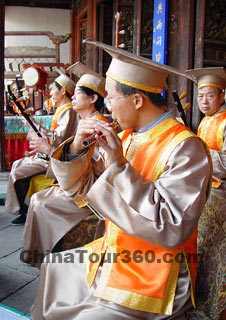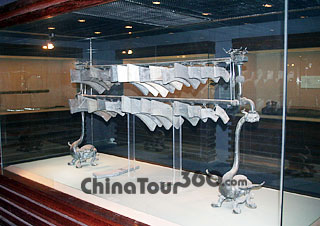 |
| Traditional Music |
![]() Traditional Chinese Music
Traditional Chinese Music
In China, music is as old as its civilization. Instruments excavated from sites of the Shang Dynasty (17th - 11th century BC) include stone chimes, bronze bells, panpipes, and the Sheng. When European music was just experiencing its first breath of life, a complete theory and sophisticated instruments were already appearing in China. The orthodox ritual music was advocated by Confucius, who conceived of music in the highest sense as a means of calming the passions and of dispelling unrest and lust. By the Han Dynasty (206 BC - 220 AD), the imperial court set up a Music Bureau, which was in charge of collecting and editing ancient melodies and folk songs. Because of commercial contacts with Central Asia, foreign music was introduced in China. By the time of Emperor Xuanzong of the Tang Dynasty (618 - 907), the court organized the Pear Garden Academy song and dance troupe which cultivated a large number of musicians and laid a firm foundation.
Melody and tone quality are prominent expressive features of Chinese music, and great emphasis is given to the proper articulation and inflection of each musical tone. Most is based on the five-tone, or pentatonic, scale, but the seven-tone, or heptatonic scale, is also used, often as an expansion of a basically pentatonic core. The pentatonic scale was much used in older music. The heptatonic scale is often encountered in northern folk music.
 |
| Ancient Chime |
The variations of rhythm, beat, tone quality, and embellishments in traditional Chinese music are highly distinctive and unlike their Western counterparts. This is mainly due to the unique sounds and playing styles of traditional musical instruments which can be divided into four basic categories based on the method by which they are played. The first category includes the bowed- strings, or Hu Qin, which are made of wood with a piece of snakeskin stretched over the sound box. They have two strings, and the bow is permanently caught in between the two strings. The second category includes the plucked-strings, of which there are three types: dulcimers, lutes, and harps. The harp is made of either wood or bamboo with steel strings. In the past, the strings were made of silk. The third category encompasses the woodwind section. There are flutes, pipes, and trumpets which use double reeds like the oboe but sound like a trumpet. The final category encompasses the percussion section. The main instruments include drums, timpani, gongs, and cymbals. For some songs, bells, xylophones, tuned gongs, and the triangle are used. The percussion section is called the wu-chang, or martial scene, in traditional Chinese opera.
In traditional orchestras, the combination of all the different instruments served to create a harmonious and beautiful auditory atmosphere. Unbelievingly beautiful music was made and is still made. Many instruments can produce purely unique and amazing sounds. Some famous traditional pieces have been amassed below for your listening pleasure.
 |
| Ethnic Group Music |
![]() Modern Chinese Music
Modern Chinese Music
Today's music in China is quite similar to that of modern Western's. Just like young Westerners, now young people in China attend the concerts of famous pop stars. Modern orchestras play both adapted versions of traditional pieces and classical and modern symphonic compositions.
In modern music, many traditional facets still remain. Many traditional instruments are used in conjunction with popular instruments of Western cultures. The mixing of traditional instruments with western instruments creates a wide variety of euphonious sounds and rhythms, and the mixing with western styles of singing creates unique sounds. Many modern artists also incorporate traditional melodies into their songs, so even music using only popular Western instruments sounds different. The mixing of Western and oriental styles with traditional instruments and other instruments allows for the creation of an endless scope of expression with modern music.
Many modern instrumental music incorporate traditional instruments while adapting a more modern style. However, it is still very traditional. Many works are still played by small quartets and large orchestras. The melodies are quite unique and incorporate into many modern compositions. It has changed because it is no longer restricted to the traditional format. Even non-traditional instruments such as the piano are used in creating modern works.
![]() See Qin Zither
See Qin Zither







